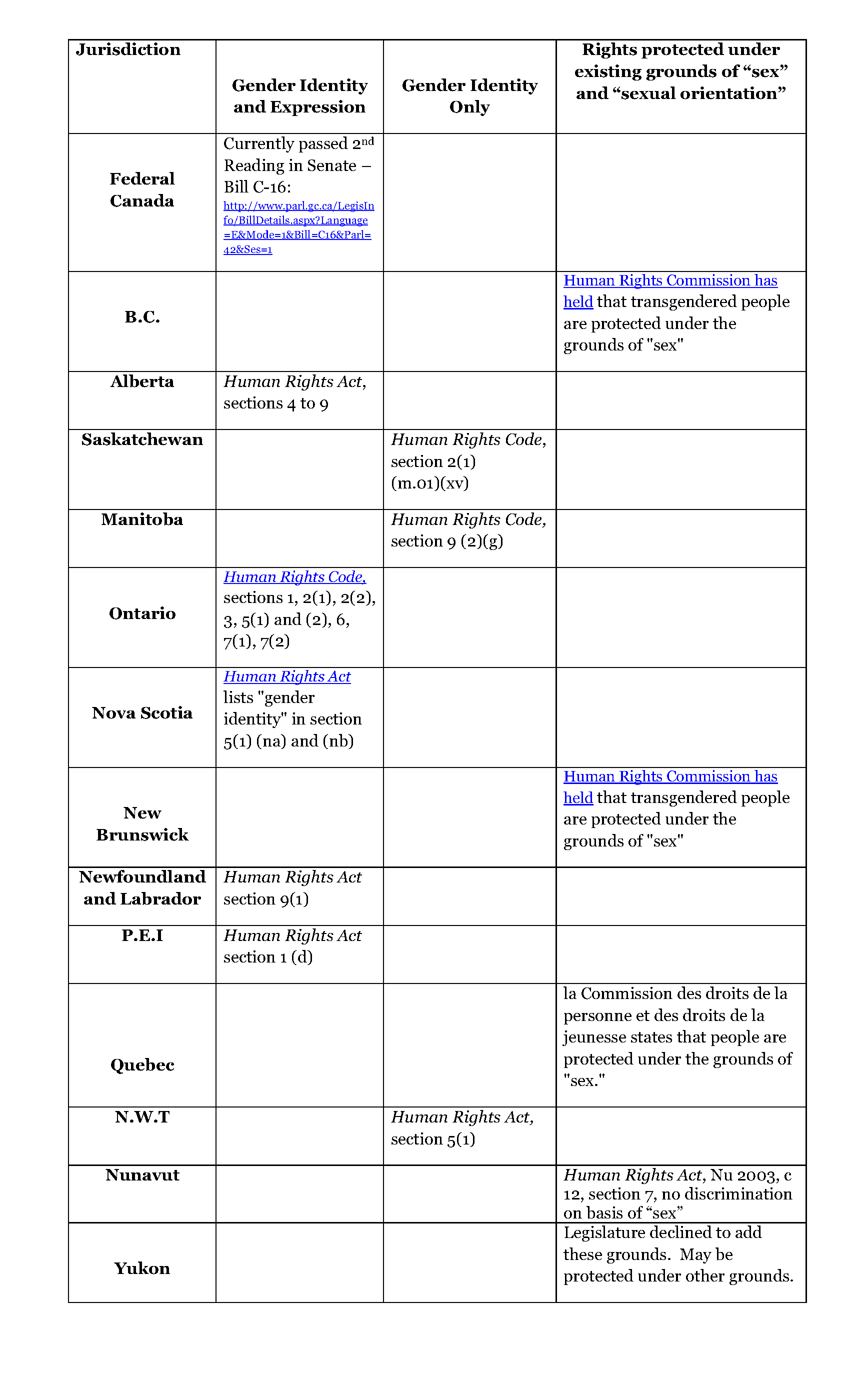 The most recent personal attributes added to the list of prohibited grounds of discrimination in Canadian human rights are “gender identity” and “gender expression.” This is generally viewed as facilitating gender diversity and, in particular, establishing legal rights and protections for transgender persons, who are also described as gender non-conforming.
The most recent personal attributes added to the list of prohibited grounds of discrimination in Canadian human rights are “gender identity” and “gender expression.” This is generally viewed as facilitating gender diversity and, in particular, establishing legal rights and protections for transgender persons, who are also described as gender non-conforming.
Alberta is the latest province to add these prohibited grounds of discrimination to the legislation to protect individuals in employment, residential accommodation, the provision of facilities and services, contracts, and in public advertising and signage. “Gender identity and gender expression” were added by Bill 7, the Alberta Human Rights Amendment Act which received royal assent in 2015.
This article will describe what these prohibited grounds mean and how the fourteen various jurisdictions in the country have legislated with respect to the issue.
Definitions
The terms “gender identity” and “gender expression” are consistently used in the human rights realm. However, they are terms of recent vintage and are not widely understood or distinguished.
The current federal Bill C-16 would also amend the Criminal Code to include “gender identity” and “gender expression” as grounds for hate crimes.Human rights legislation does not define “gender identity” and “gender expression”. However, such legislation (as in Alberta) does at least partially define other prohibited grounds, such as age, family status, marital status, mental disability, physical disability, religious beliefs and source of income. The interpretation of these terms will ultimately fall to judges.
In the meantime, some human rights tribunals themselves have administratively offered definitions according to which they will operate. For example, the Ontario Human Rights Commission issued a non-legally binding interpretation bulletin that defines “gender identity” and “gender expression” as follows:
Gender identity is each person’s internal and individual experience of gender. It is their sense of being a woman, a man, both, neither, or anywhere along the gender spectrum. A person’s gender identity may be the same as or different from their birth-assigned sex. Gender identity is fundamentally different from a person’s sexual orientation.
Gender expression is how a person publicly presents their gender. This can include behaviour and outward appearance such as dress, hair, make-up, body language and voice. A person’s chosen name and pronoun are also common ways of expressing gender.
An Ontario Human Rights Tribunal held in 2012 that genital surgery was not required for someone to be legally recognized as the other gender.
Existing Legal Protection Without the New Amendments
Other legislative amendments have also been passed as a result of Charter challenges.Most Canadian provinces and territories have held that anyone whose gender identity or expression is different than their birth-assigned gender has always been protected under the “gender” or “sex” prohibited ground of discrimination rubric. This is in the same way that sexual harassment has been understood to be encompassed, without specific language indicating so, as discrimination on the basis of gender or sex. For example, the Alberta Human Rights Complaint form and guide states that discrimination regarding gender “includes the state of being female, man, transgender or two spirited”.
On the other hand, gender or sex is a broader category than “gender identity” and “gender expression”. As the Ontario Human Rights Tribunal definition points out, sexual orientation is a completely independent protected human attribute in the same legislation.
“Gender identity and gender expression” were added by Bill 7, the Alberta Human Rights Amendment Act which received royal assent in 2015.Why would a legislature specifically enumerate “gender identity” and “gender expression” when they are already attributes encompassed by protection against discrimination on the basis of gender or sex, which is found in all Canadian human rights legislation? The legislators in each jurisdiction will have their own reasons for legislating the specific alongside the general. It may be due to a contemporary desire to enact clear and explicit safeguards for the gender non-conforming community.
Canadian Legal Landscape for Transgender Equality Rights
Several Canadian jurisdictions have chosen not to specifically add “gender identity” and “gender expression” to their human rights legislation. These are British Columbia, New Brunswick, Nunavut, Quebec and Yukon. Others – Saskatchewan, Manitoba and Northwest Territories – have added “gender identity” only. Alberta, Ontario, Nova Scotia, Newfoundland and Labrador and Prince Edward Island are the five provinces who have added both “gender identity” and “gender expression” to their legislation. At the federal level, the House of Commons has passed Bill C-16. At the time of this writing, this Bill had passed Second Reading in the Senate. (See Senator Grant Mitchell’s article in this issue for further information about Bill C-16).
Several Canadian jurisdictions have chosen not to specifically add “gender identity” and “gender expression” to their human rights legislation.Other legislative amendments have also been passed as a result of Charter challenges. In C.F. v. Alberta, 2014 ABQB 237, the transgendered applicant was unable to have her new gender reflected in her birth certificate and other government identification because she had not undergone sex change surgery. The Court of Queen’s Bench concluded that the Alberta Vital Statistics Act violated the applicant’s Charter of Rights protections and was, to that extent, of no force or effect. The judge ordered the government to issue a birth certificate in her preferred gender within 30 days. A consequential update to the Vital Statistics Act and the corresponding Information Regulation followed in February 2015, which now ensures transgender individuals will have their gender identity reflected on their government- issued ID cards, driver’s licences and birth certificates.
The current federal Bill C-16 would also amend the Criminal Code to include “gender identity” and “gender expression” as grounds for hate crimes.
The table below sets out the nature of the legislation in each Canadian jurisdiction as it relates to equality rights for “gender identity” and “gender expression”.


